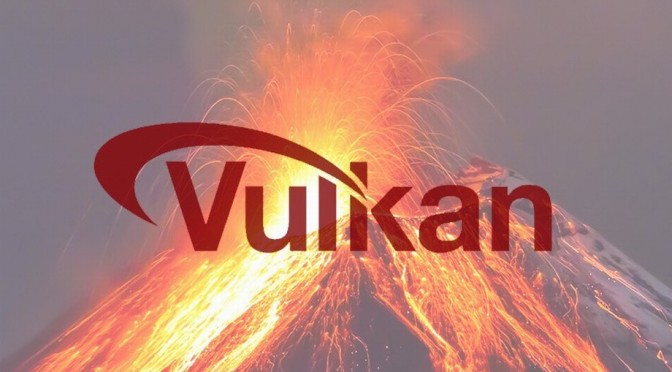The Khronos Group, an open consortium of leading hardware and software companies creating advanced acceleration standards, announced today the release of the Vulkan 1.1 and SPIR-V 1.3 specifications. Version 1.1 expands Vulkan’s core functionality with developer-requested features, such as subgroup operations, while integrating a wide range of proven extensions from Vulkan 1.0. Khronos will also release full Vulkan 1.1 conformance tests into open source and AMD, Arm, Imagination, Intel Corporation, NVIDIA and Qualcomm have implemented conformant Vulkan 1.1 drivers.
Tom Olson, distinguished engineer at Arm, and Vulkan Working Group chair, said:
“With enhanced developer tools, rigorous conformance testing and the public Vulkan Ecosystem Forum, Khronos is delivering on its goal to develop a complete and vibrant Vulkan ecosystem. Vulkan 1.1 is a response to prioritized industry requests and shows our commitment to delivering a functional roadmap driven by developer needs.”
Vulkan 1.1 promises to drive increased industry momentum for this new-generation, cross-platform standard for explicit control over GPU acceleration. Vulkan now ships natively on almost all GPU-enabled platforms, including Windows 7, 8.X, 10, Android 7.0+ and Linux, plus Khronos recently announced open source tools to enable Vulkan 1.0 applications to be ported to macOS and iOS. Vulkan has widespread support in leading games engines including Unreal, Unity, Source 2 from Valve, id Tech, CroTeam’s Serious Engine, CryEngine, and Xenko. Vulkan is being used in over 30 cutting-edge games on diverse desktop and mobile platforms, including Doom, Quake, Roblox, The Talos Principle, Dota 2, and is the exclusive API used in AAA titles such as Wolfenstein II and Doom VFR.
New functionality in Vulkan 1.1 includes Subgroup Operations that enable highly-efficient sharing and manipulation of data between multiple tasks running in parallel on a GPU. Vulkan 1.1 also enables applications to perform rendering and display operations using resources that they cannot access or copy – for secure playback and display of protected multimedia content.
In addition, a wide range of Vulkan 1.0 extensions have been integrated, bringing significant proven functionality into core Vulkan 1.1, including: simultaneous rendering of multiple image views, use of multiple GPUs in a single system, and cross-process API interoperability for advanced rendering and compositing operations often used in demanding applications such as Virtual Reality. These core functionalities also include advanced compute with 16-bit memory access, and support for HLSL memory layouts, and display, processing and compositing of video streams, through direct sampling of YCbCr color formatted textures produced by many video codecs.
Integral to the release of Vulkan 1.1 is the new SPIR-V 1.3 specification that expands the capabilities of the Vulkan shader intermediate representation to support subgroup operations and enable enhanced compiler optimizations. The SPIR-V tools ecosystem continues to gain significant momentum with front-end compilers for both GLSL and HLSL, and to expand low-level tooling support from the open source SPIRV-Tools project.
David Neto, shader compiler team lead at Google and SPIR working group chair, added:
“We are excited to see the progress developers have made with the SPIR-V standardized IR. Developers are using the shader language of their choice and a variety of open source compilers to ship their games and applications. The Vulkan tools and ecosystem is evolving rapidly.”
Andrej Zdravkovic, corporate vice president of software, AMD, said:
“AMD is very excited about the release of the Vulkan 1.1 specifications. This new iteration of the industry standard builds on its strong foundations and expands its reach by making the API more accessible to developers. New Vulkan 1.1 features such as subgroup access in compute shaders enable console-like optimizations that will empower developers to exert more control on the GPU than ever before. Vulkan also enriches its connectivity with other APIs by supporting interop operations, and finally enables first-class support for multi-GPU and VR systems. AMD believes that this major upgrade to the API will delight the existing Vulkan community and continue to broaden the user base.”
Dwight Diercks, senior vice president of software engineering, NVIDIA, added:
“Vulkan is vital to NVIDIA’s business as it enables developers to get the best from our GPUs across a wide range of platforms. Our Vulkan 1.1 drivers, with full subgroup functionality, are available for Windows, Linux, and Android on the day of the specification launch. We will continue to take a leadership role within Khronos to ensure Vulkan evolves to meet the needs of developers and the wider industry.”
Vincent Hindriksen, managing director of StreamHPC, concluded:
“Vulkan 1.1 and SPIR-V 1.3 are another step in providing better support for compute, as it adds subgroups, 16-bit numbers and a restricted form of pointers. Adding this to the strong industry support for Vulkan and the recently launched portability project, this allows more types of compute-kernels to be run on more platforms.”

John is the founder and Editor in Chief at DSOGaming. He is a PC gaming fan and highly supports the modding and indie communities. Before creating DSOGaming, John worked on numerous gaming websites. While he is a die-hard PC gamer, his gaming roots can be found on consoles. John loved – and still does – the 16-bit consoles, and considers SNES to be one of the best consoles. Still, the PC platform won him over consoles. That was mainly due to 3DFX and its iconic dedicated 3D accelerator graphics card, Voodoo 2. John has also written a higher degree thesis on the “The Evolution of PC graphics cards.”
Contact: Email

